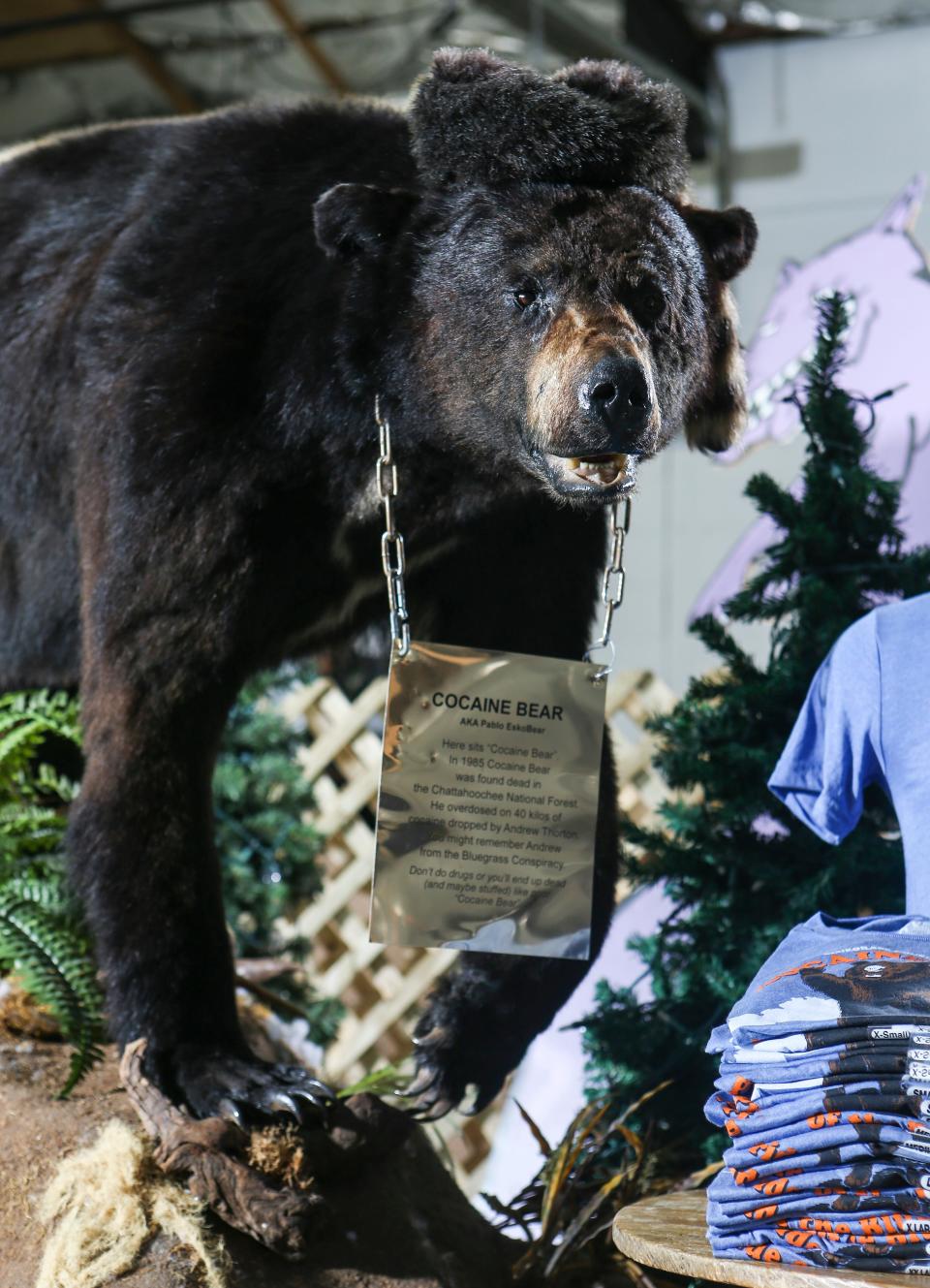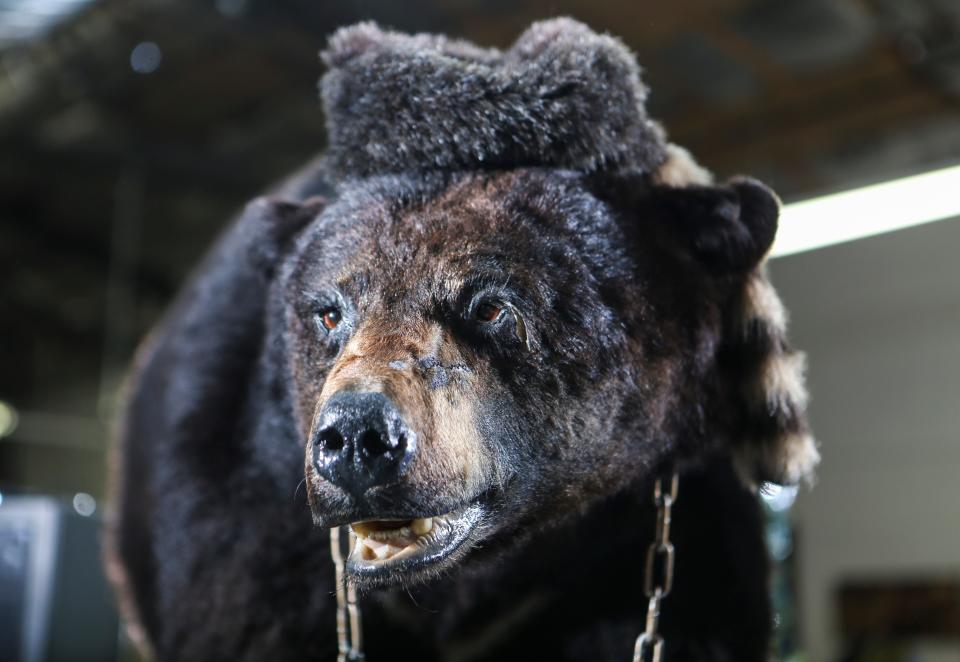What's the true story behind Cocaine Bear? Meet Kentucky's wildest, drug-fueled legend
- Oops!Something went wrong.Please try again later.
This story has been updated to reflect a change in who previously owned Cocaine Bear.
LEXINGTON, Ky. — The story of Kentucky's favorite party animal is heading to Hollywood.
Our venerable "Cocaine Bear" is part of the plotline for an upcoming film.
The real-life story is stranger than fiction. Back in 1985, a 175-pound black bear died from a massive cocaine overdose at the indirect hand of one of Kentucky's most notorious drug-smuggling criminals.
The now taxidermized Cocaine Bear has captured the hearts and attention of roadside travelers since he first arrived in Lexington in 2015. The black bear with just enough teeth showing to scare some children has appeared in thousands of selfies, and he's even gotten to be the guest of honor backstage at a Sturgill Simpson concert.
The circumstances of his death were originally featured in a wild three-sentence-long New York Times brief back in 1985, and now it's part of the plot of a new movie being developed and directed by actress and director Elizabeth Banks.

It's happening:'Cocaine Bear' finally has a release date. When and where you can watch, stream it
With the upcoming film in mind, now seems like as good a time as any to revisit the legend and the story of how he ended up stuffed and on display at the Kentucky for Kentucky Fun Mall at 720 Bryan Ave. in Lexington.
Interestingly enough, I took a trip to Lexington on March 4, 2020, pre-COVID, to meet the bear and the small staff of retail employees dedicated to preserving his story.
I waited to write that story because the coronavirus shutdown happened the following week and teasing about an attraction that wasn't open to the public didn't seem fair.
But now, it's finally time to introduce you to Cocaine Bear.
Is Cocaine Bear based on a true story?
Here's the hard, sad truth. This bear ate cocaine until it died.
When a medical examiner was called in back in 1985 to look at the 175-pound body, he found every problem you'd expect from a massive overdose — cerebral hemorrhaging, respiratory failure, hyperthermia, renal failure, heart failure, stroke.
Cocaine Bear's stomach was so full, you couldn't have packed in more of the illicit drug if you tried.
But how did he get that way? It starts three months earlier and 200 miles to the north. It was there that Andrew Thornton II, a notorious Lexington narcotics police officer turned drug smuggler, fell to his death from a plane while on a coke-smuggling run. He just returned from dropping packages in northern Georgia.
His body was recovered in Knoxville, Tennessee, with night-vision goggles on his face and Gucci loafers on his feet. He had knives, a couple of pistols, $4,500 in cash and a duffel bag filled with about 75 pounds of cocaine worth $15 million on him too.
You may like: A jilted lover. A double homicide. Inside the Kentucky Murder Mansion's twisted love story
The two deaths are widely believed to be connected because the bear was surrounded by 40 open containers with traces of cocaine inside of them.
Thirty-six years later, even though he's a technically Georgia black bear, Cocaine Bear is a Kentucky legend for dying at the indirect hand of one of the commonwealth's most wanted.
The notoriety doesn't stop at his last coke-filled breaths.
Cocaine Bear's next 25 or so years are equally as wild.
Kentucky for Kentucky's bear hunt

The folks behind Kentucky for Kentucky first reached out to the Georgia Bureau of Investigations to try and find out what happened to the bear back in 2013 or 2014.
This might seem unusual for a retail store, but Kentucky for Kentucky is not your average shop. This is the same vivacious retailer that sells preserved dung from Kentucky Derby champions for $200 a jar and once tie-dyed shirts in Kentucky Fried Chicken gravy.
They have a history of taking on bizarre projects that give a shot in the arm to the state's morale and culture.
Back in 2011, they launched a Kickstarter campaign to fund a Super Bowl commercial for the state. At one point they set up a 1-800 line so that Kentuckians, who had moved away, could call in and hear "My Old Kentucky Home" for the holidays. A few years ago they took it upon themselves to rebrand the state's slogan from "Unbridled Spirit" to "Kentucky Kicks Ass."
You may like: It took 29 years, but this Kentucky man returned a long lost class ring to its owner
The bear hunt for an animal that had been dead for nearly 30 years was just another wild idea until they reached out to the Georgia Bureau of Investigations. The agency remembered the old case for its sheer absurdity.
Together they traced Cocaine Bear's past and its once coked-out insides to a medical examiner who'd looked over the bear's remains back in the 1980s.
Eventually, they learned Mr. Bear, as Kentucky for Kentucky co-owner Whit Hiler affectionately calls him, was taxidermized after his death and put on display at the Chattahoochee River National Recreation Area in Georgia.
Hiler initially told us in that 2020 interview that the bear was once owned by country music legend Waylon Jennings. In a statement to USA Today, a representative for son Shooter Jennings said his father never owned a taxidermy bear. And while Fun Mall representatives have not returned calls for comment, the owners did tell the Wall Street Journal that after inheriting a stuffed bear in 2015, they created a backstory that wove real details about the dead bear "with heavy embellishments."
By the time the Kentucky for Kentucky team found the bear about eight years ago, its most recent post was as a decoration in a traditional Chinese medicine shop in Reno. The team connected with the widow of the man who owned the store, and she agreed to give Cocaine Bear to the Lexington retailers, as long as they paid the $200 shipping. (The sale of one of those horse turd jars could have funded that voyage.)
It was a no-brainer for Hiler and his associates.
Sharing the spotlight with Sturgill Simpson

Christian Phillips was running the Fun Mall's checkout the afternoon I met the bear. He's both a store clerk and witness to all travelers who flock to Lexington to see this drug-fueled legend.
I'd driven more than 75 miles from Louisville to see Cocaine Bear, but that trip was short compared to many of the bear's biggest fans.
Since Phillips had started working there two years before when I spoke to him in March 2020,he'd met folks from Sweden, Australia, Poland, Finland, and parts of Africa, who'd all heard about the Cocaine Bear online and wanted to see him.
Since the pandemic hit Kentucky a year ago, Cocaine Bear's public appearances have been essentially non-existent.
Kentucky for Kentucky has been running as an online shop and curbside operation since the shutdown last spring.
But this time last year, Cocaine Bear had just returned from a quick excursion to Rupp Arena. He doesn't usually leave the store, but a few months before, Cocaine Bear received a shoutout on comedian Joe Rogan's podcast when Kentucky-born country singer Sturgill Simpson was a guest.
So when Simpson took the stage at Rupp Arena in February 2020, the Fun Mall was delighted to send Cocaine Bear backstage for the whole crew to enjoy.
You may like: End of an era. The last video rental chain in Kentucky is closing its last few stores
Phillips told me that prior to the shutdown, the store welcomed a "bear minimum" of five Cocaine Bear fans a day. Usually, it was closer to 20 or 30 people.
I circled back with Hiler after the news of the film broke this week, and he told me people are thrilled about it. His social media had been booming, and once again, interest around Cocaine Bear had taken off.
Life has been pretty slow during the shutdown, he said, and they're excited to get people back into the store.
They're eager to put Cocaine Bear back on display once it's safe again, too.
It's not uncommon to have people walk in the door, make a beeline for the bear and start taking selfies. Others have found him more organically.

Kentucky for Kentucky has a whole line of merchandise for Mr. Bear including a "blow globe," which is really a snow globe and a pun that nods to the party animal's past.
If you see enough T-shirts, stickers and hats with "Cocaine Bear" on them, it's hard not to ask, Phillips told me. He enjoys sharing the story.
People devour it the same way the bear gobbled up all that cocaine. This new plug from Hollywood will only add to it.
Cocaine Bear has been dead for 36 years, but the story has very much taken on a life of its own.
Features columnist Maggie Menderski writes about what makes Louisville, Southern Indiana and Kentucky unique, wonderful, and occasionally, a little weird. If you've got something in your family, your town or even your closet that fits that description — she wants to hear from you. Say hello at mmenderski@courier-journal.com or 502-582-7137. Follow along on Instagram and Twitter @MaggieMenderski. Support strong local journalism by subscribing today: courier-journal.com/maggiem.
This article originally appeared on Louisville Courier Journal: The true story behind Cocaine Bear, Kentucky's drug-fueled legend

